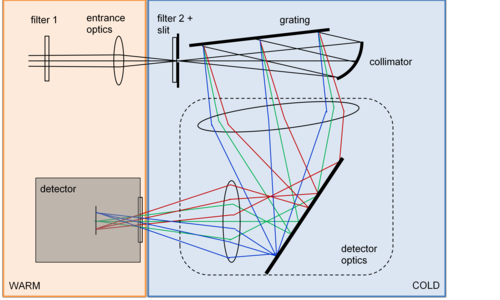Design and Development of the VenSpec-H Instrument
- 1Belgian Institute for Space Aeronomy, Brussels, Belgium (jurgen.vanhamel@aeronomie.be)
- 2OIP Sensor Systems, Oudenaarde, Belgium
- 3ESTEC - European Space Agency
Introduction:
VenSpec-H (Venus Spectrometer with High resolution), part of ESA’s EnVision M5 mission to Venus, is currently in Phase A (started in January 2019) in which the feasibility of the instrument is studied. The instrument successfully passed the mid-term mission consolidation review (May 2020). The mission selection review by ESA is planned beginning 2021.
Scientific objectives:
EnVision aims at the investigation of the geo-logical activity on Venus and its relationship with the atmosphere, in order to understand how Venus and Earth could have evolved so differently.
The VenSpec suite consists of VenSpec-H and two other instuments, VenSpec-M, an IR mapper, and VenSpec-U, a UV spectrometer. The overall scientific objective of this suite is to search for temporal variations in surface temperatures and tropospheric concentrations of gases indicative for volcanic eruptions. Additionally, the study of surface-atmosphere interactions and weathering by mapping surface emissivity and tropospheric gas abundances is also part of the mission.
The goal of the VenSpec-H instrument is to target different molecular species related to volcanism and surface changes on Venus. The measurement of the H2O and HDO constituents of the Venus’ atmosphere, as well as the probing of H2O, HDO, CO, OCS, SO2 in a 30 – 40 km altitude range is planned on the nightside and above the cloud top on the dayside. Several spectral windows are used to monitor these constituents in the range of 1 to 2.5 µm. VenSpec-H works in a nadir viewing geometry.
Instrument design:
VenSpec-H is a spectrometer, hence, the heart of the instrument consists of a spectrometer section where the incoming uniform light is diffracted into its spectral components. This section is cooled down to approximately -45 °C in order to suppress as much as possible the thermal background. This is achieved by means of a large dedicated radiator. The warm baseplate is kept around 0 °C (by means of a small warm section radiator). The warm baseplate is mounted to the spacecraft deck using three kinematic feet.
The diffracting element in VenSpec-H is an echelle grating. The incoming light is first rendered parallel on a parabolic mirror before it hits the grating. The parallel light diffracted from the grating is focused by a dedicated optical system towards the detector.
The cold spectrometer section is preceded by a warmer band selection section. It is a combination of a filter wheel and a butcher’s block of two horizontal filters (on top of the spectrometer entrance slit).
The spectrometer section is followed by the detector section. The detector is an Integrated Dewar Detector Cooler Assembly (IDDCA). The dewar window sits in the exit aperture of the spectrometer section. The Focal Plane Array (FPA) is located a bit further in the focal plane of the spectrometer exit optics. The FPA is cooled by means of a cryocooler.
Preliminary optical and thermal analysis and modelling has been performed.
The instrument design relies partly on heritage from the NOMAD instrument, which is a spectrometer suite on board ESA’s Trace Gas Orbiter (TGO) satellite, a part of the ExoMars 2016 mission.

Ongoing tests:
Currently, thermo-mechanical prototyping work is performed using the facilities at BIRA-IASB, in order to prove the feasibility of some critical systems. One of the most critical elements in the VenSpec-H design is the cold section and its interconnection to a warm support structure. Several tests are planned.
In a first series of tests, the thermal conductivity is investigated by using different types of feet. Using a fixed cold temperature at one side, and knowing heat injection at other side, a ΔT can be determined.
In a second series of tests, the mounting mechanism of the cold section onto the warm section using a fixed connection on one side and a gliding pin on the other side, is tested. For this, an instrument prototype (including mass dummies for optical elements) is used, keeping the cold section at -25°C, while the warm base plate is at +20°C, the retraction and dilatation of the cold section is measured using capacitive sensors.
The different results obtained during these tests will be presented at the conference.
Acknowledgements:
This work has been performed with the support of the Belgian Science Policy Office (BELSPO), with the financial and contractual coordination by the ESA Prodex Office.
How to cite: Vanhamel, J., Vandaele, A.-C., Neefs, E., Robert, S., Jacobs, L., Berkenbosch, S., Thomas, I., Beeckman, B., Moelans, W., Lesschaeve, S., Algoedt, A., De Vos, L., and Vaughan, M.: Design and Development of the VenSpec-H Instrument, Europlanet Science Congress 2020, online, 21 September–9 Oct 2020, EPSC2020-535, https://doi.org/10.5194/epsc2020-535, 2020

